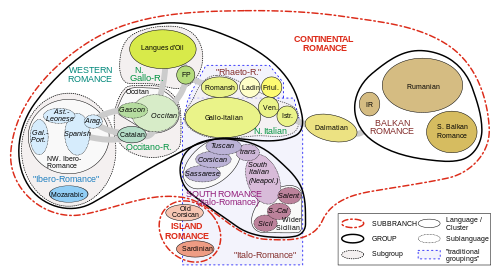Emilian-Romagnol language
| Emilian-Romagnol | |
|---|---|
| Native to | Italy, San Marino |
| Region | Primarily Emilia-Romagna, Marche, San Marino |
Native speakers | Unknown (4.4 million population):
|
Indo-European
| |
| Dialects | |
| Language codes | |
| ISO 639-3 | (code eml deprecated in 2009)[2] Individual codes: egl – Emilianrgn – Romagnol |
| Glottolog | emil1241 Emilianoroma1328 Romagnol |
| Linguasphere | 51-AAA-ok |
 | |
Emilian-Romagnol (emiliân-rumagnōl or längua emiglièna-rumagnôla), also known as Emiliano-Romagnolo, is a Gallo-Italic language spoken in the Northern Italian region of Emilia-Romagna.[3] The language is divided into two main varieties: Emilian and Romagnol. While the language was first registered under a single code in ISO standard 639-3, in 2009 this code was retired in favour of two distinct codes for the two varieties, due to the cultural and literary split between the two parts of the region, making Emilian and Romagnol distinct ethnolinguistic entities.[4] Emilian and Romagnol (entered separately) are considered definitely endangered languages according to the UNESCO Atlas of the World's Languages in Danger.[5][6]
Description[]

As a Gallo-Italic language, Emilian-Romagnol is most closely related to the Lombard, Piedmontese and Ligurian languages, all of which are spoken in neighboring provinces.
Among other Gallo-Italic languages, Emilian-Romagnol is characterized by systematic raising and diphthongization of latin stressed vowels in open syllables, as well as widespread syncope of unstressed vowels other than /a/ and use of vowel gradation in the formation of plurals and certain verb tenses.[3]
See also[]
| Emiliano-Romagnolo edition of Wikipedia, the free encyclopedia |
References[]
- ^ "La lingua italiana, i dialetti e le lingue straniere Anno 2006" (PDF). istat.it. Retrieved 21 February 2018.
- ^ "639 Identifier Documentation: eml". SIL International.
- ^ Jump up to: a b Loporcaro, Michele (2009). Profilo linguistico dei dialetti italiani. Bari: Laterza. pp. 104–108. ISBN 978-88-420-8920-9. OCLC 318631969.
- ^ "eml | ISO 639-3". iso639-3.sil.org. Retrieved 2021-08-21.
- ^ "UNESCO Atlas of the World's Languages in danger". www.unesco.org. Retrieved 2021-08-21.
- ^ "UNESCO Atlas of the World's Languages in danger". www.unesco.org. Retrieved 2021-08-21.
- Emilian-Romagnol language
- Gallo-Italic languages
- Languages of Italy
- Languages of Emilia-Romagna
- Languages of Lombardy
- Languages of Liguria
- Languages of le Marche
- Languages of San Marino
- Romance language stubs